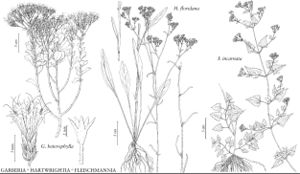Fleischmannia
Flora 33: 417. 1850.
| Taxon | Illustrator ⠉ | |
|---|---|---|
 | Garberia heterophylla Hartwrightia floridana Fleischmannia incarnata | Linny Heagy Linny Heagy Linny Heagy |
Annuals or perennials [subshrubs], 30–120+ cm (crowns fibrous-rooted). Stems erect, simple or sparingly branched (usually puberulent, hairs curled). Leaves cauline; opposite [alternate]; petiolate; blades 3-nerved, deltate-ovate or triangular-deltate [elliptic, rhombic], margins ± crenate to serrate, faces glabrous, sometimes glanddotted. Heads discoid, in loose, corymbiform arrays. Involucres obconic to hemispheric, 2–4 mm diam. Phyllaries persistent, 20–30 in 2–4 series, 2–3-nerved, lanceolate to linear, unequal [subequal] (herbaceous to chartaceous). Receptacles flat or slightly convex [conic] (glabrous or with scattered hairs), epaleate. Florets 15–25 [10–50]; corollas bluish, pinkish, purplish, or white, throats narrowly funnelform (lengths 2.5–4 times diams.); styles: bases not enlarged, glabrous, branches linear-filiform. Cypselae prismatic, 5 (–8) -ribbed, glabrous or sparsely hirtellous; pappi ± persistent or fragile, of [0 or 5–] 20–40, barbellate bristles in 1 series. x = (4) 10.
Distribution
se, s, c United States, Mexico, Central America, Andean South America
Discussion
Species ca. 80 (2 in the flora).
Fleischmannia is “superficially similar to Ageratina, which is distinguished from it by the less well developed carpopodium (not stopper-like and sharply set off from the body as in Fleischmannia), usually imbricate involucral bracts, and base chromosome number of x = 17 (versus 4 or 10 in Fleischmannia)” (R. M. King and H. Robinson 1987).
Selected References
None.
Lower Taxa
Key
| 1 | Stems lax, sprawling or scandent; involucres 4–5 mm; outer phyllaries lanceolate, inner lanceolate to narrowly oblong-lanceolate, apices usually acute to attenuate, sometimes rounded; cypselae 1.8–2.8 mm | Fleischmannia incarnata |
| 1 | Stems erect to ascending-erect (not sprawling-scandent); involucres 3–3.5 mm; outer phyllaries ovate, inner elliptic, apices usually obtuse to rounded, rarely truncate; cypselae 1–1.2(–1.5) mm | Fleischmannia sonorae |
"fine" is not a number.